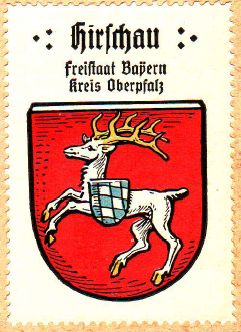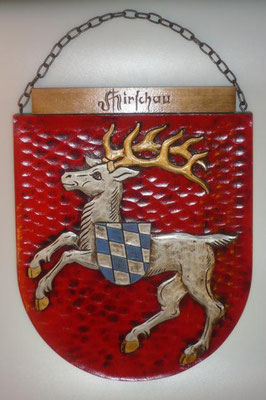Hirschau (Oberpfalz): Difference between revisions
Knorrepoes (talk | contribs) m (Text replacement - "|center|Wappen von {{PAGENAME}}]] " to "|center|alt=Wappen von {{PAGENAME}} / Arms of {{PAGENAME}}]] ") |
Knorrepoes (talk | contribs) m (Text replacement - " / Arms" to "/Arms") |
||
| Line 7: | Line 7: | ||
Additions : 1971 Ehenfeld; 1978 Massenricht | Additions : 1971 Ehenfeld; 1978 Massenricht | ||
[[File:hirschau.jpg|center|alt=Wappen von {{PAGENAME}} / Arms of {{PAGENAME}}]] | [[File:hirschau.jpg|center|alt=Wappen von {{PAGENAME}}/Arms of {{PAGENAME}}]] | ||
{| class="wikitable" | {| class="wikitable" | ||
Revision as of 11:07, 2 September 2022
This page is part of the German heraldry portal Deutsche Wappensammlung |
Heraldry of the World |
|
German heraldry:
|
Selected collector's items from Germany:
|
HIRSCHAU
State : Bayern
District (Kreis) : Amberg-Sulzbach (until 1972 Amberg)
Additions : 1971 Ehenfeld; 1978 Massenricht
| German |
In Rot ein springender, golden bewehrter, silberner Hirsch, dem vorne ein Schildchen mit den bayerischen Rauten aufgelegt ist. |
| English | (Oberpfalz) No blazon/translation known. Please click here to send your (heraldic !) blazon or translation |
Origin/meaning
Hirschau received city rights around 1300 from the Kings of Bohemia. In 1373 the city was acquired by the Wittelsbach family, Dukes of Bayern. The oldest seal is known from 1467 and already shows a canting deer (Hirsch) with the small shield of the Wittelsbach family. The arms basically never changed since, except that sometimes small pine trees were added around the deer. These were also canting (Au or forest). The historical arms were restored at the beginning of the 20th century.
| The municipal stamp shown in 1892 |
The arms by Hupp in the Kaffee Hag albums +/- 1925 |
| The arms in the Deutsches Wappenmuseum |
Contact and Support
Partners:
Your logo here ?
Contact us
© since 1995, Heraldry of the World, Ralf Hartemink 
Index of the site
Literature : Stadler, 1964-1971, 8 volumes; Hupp, O: Kaffee Hag albums, 1920s















